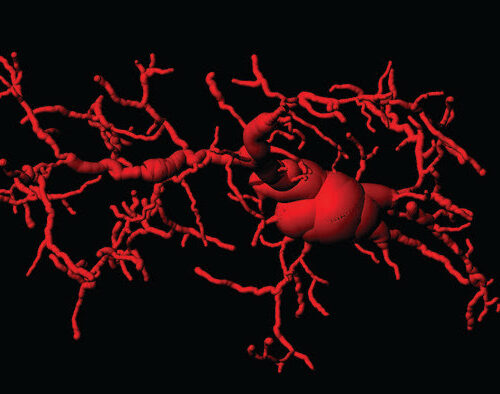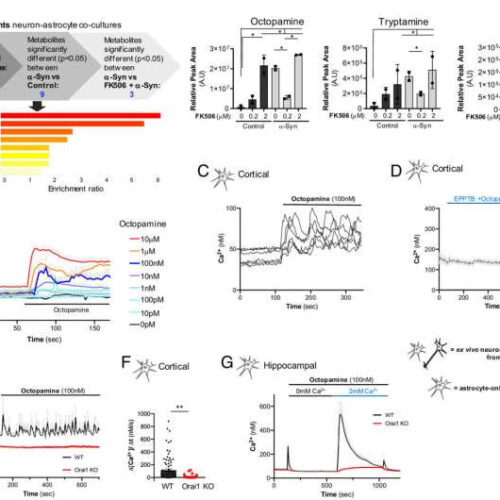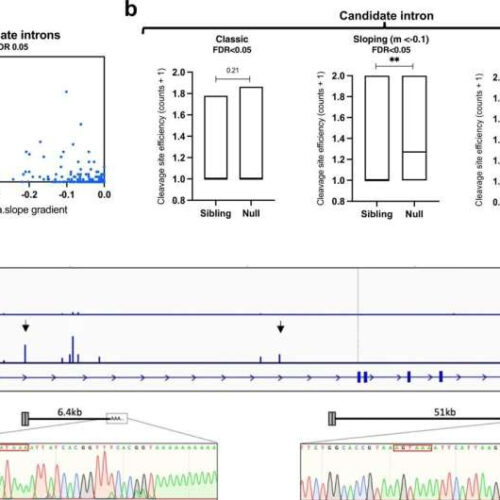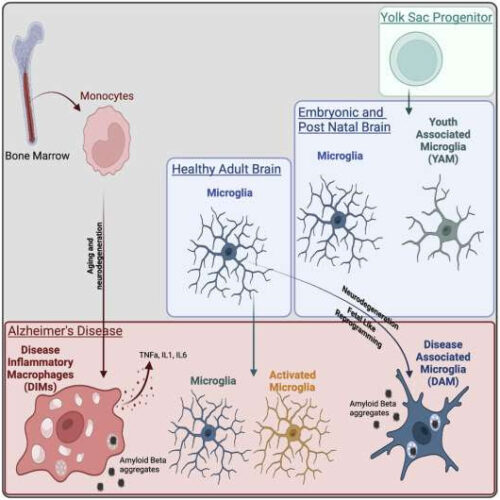ECOLE POLYTECHNIQUE FÉDÉRALE DE LAUSANNE IMAGE: AN ACTIVATED MICROGLIAL CELL IN THE BRAIN OF CGAS/STING ACTIVATED MICE. CREDIT: GULEN ET AL. NATURE 02 AUGUST 2023. DOI: 10.1038/S41586-023-06373-1 As we age, our bodies undergo various changes that can impact our overall health and make us more susceptible to diseases. One common factor in the ageing process...
Tag: <span>neurodegeneration</span>
Understanding the role of octopamine in neurodegeneration
by Olivia Dimmer, Northwestern University Octopamine is a calcineurin-dependent metabolite released under α-syn proteotoxicity that mediates Ca2+ influx in astrocytes. (A) Metabolite screen from supernatants of rat primary cortical neuron–astrocyte cocultures transduced with either control lentivirus or α-synA53T driven by the synapsin promoter and treated with either vehicle (DMSO) or subsaturating (0.2 µM) doses of FK506 5 to...
RNA modification ‘pivotal’ for protein linked to neurodegeneration in ALS
MICHIGAN MEDICINE – UNIVERSITY OF MICHIGAN Nearly 100% of cases of amyotrophic lateral sclerosis—the progressive, fatal neurodegenerative disease known as ALS or Lou Gherig’s disease — involve the buildup of a protein called TDP-43. Scientists know that TDP-43, which helps regulate processing of RNA, may be responsible for the death of nerve cells in ALS...
Researchers reveal a new ALS hallmark, shedding light on a likely trigger of neurodegeneration
by King’s College London PreT-IR transcripts undergo cleavage/polyadenylation and neurite localisation in SFPQ-deprived neurons. a Correlation between RNAseq read slope gradient in null and number of cleavage sites in introns of sloping IR-transcripts. Two-tailed Pearson correlation coefficient, r: −0.3506, p < 0.0001 (n = 247 sloping IR-transcripts, FDR < 0.05). b Efficiency of cleavage site usage in classic (Left; (n = 107, FDR < 0.05)) and sloping (Middle; (n = 37, m < −0.1, FDR < 0.05)) IR-transcripts...
Newly identified cell population could improve targeting of relevant macrophage populations in neurodegeneration
by Agency for Science, Technology and Research (A*STAR), Singapore The DAM population corresponds to a fetal-like reprogramming similar to Youth-Associated Microglia while DIMs appear during aging and increase in neurodegenerative diseases. Credit: A*STAR’s Singapore Immunology Network (SIgN) A research study published in Immunity has found that the previously identified disease-associated microglia (DAM) population detected in murine Alzheimer’s...
Neurodegeneration can be studied long before symptoms arise
by Linköping University Lech Kaczmarczyk and Susanne Bauer study changes in the brain in very early stages of neurodegenerative diseases. Credit: John Karlsson/Linköping University Many changes take place in the brain long before symptoms appear. This has been shown in mice in two studies of prion diseases in which the brain gradually deteriorates. The results...
Link between specific brain protein and vulnerability to temporal lobe epilepsy neurodegeneration discovered
by Audrey Post, Florida State University Graphical abstract. Credit: Journal of Neurophysiology (2022). DOI: 10.1152/jn.00070.2022 A team of Florida State University College of Medicine researchers has found a link between a specific protein in the brain and increased vulnerability to neurodegeneration for individuals with temporal lobe epilepsy (TLE). Their findings are published in the Journal of Neurophysiology. TLE is...
Proportion of mutations in cellular protein drives neurodegeneration
Tubulinopathies are a group of rare developmental and degenerative diseases that primarily affect the nervous system. While research has linked genetic mutations with these diseases, it’s less clear how these mutations specifically affect cells and trigger dysfunctions. In a new study, Yale scientists identify one particular genetic mutation that impairs brain cells. They also reveal the cellular...
A cure for Alzheimer’s is taking longer than expected; here’s why
by Carnegie Mellon University, Department of Chemical Engineering Anne Robinson, head of Carnegie Mellon’s Chemical Engineering Department, conducts research in her lab. Credit: Carnegie Mellon Chemical Engineering In her latest research paper, published in the Journal of Molecular Neuroscience, Anne Robinson, Head of Carnegie Mellon’s Department of Chemical Engineering, explains why understanding the progression of neurodegeneration...
ADHD DRUG MAY PROTECT AGAINST ALZHEIMER’S NEURODEGENERATION
Boosting levels of the neurotransmitter norepinephrine with atomoxetine, a repurposed ADHD medication, may be able to stall neurodegeneration in people with early signs of Alzheimer’s disease, according to a new study. The results appear in the journal Brain. This is one of the first published clinical studies to show a significant effect on the protein tau,...







